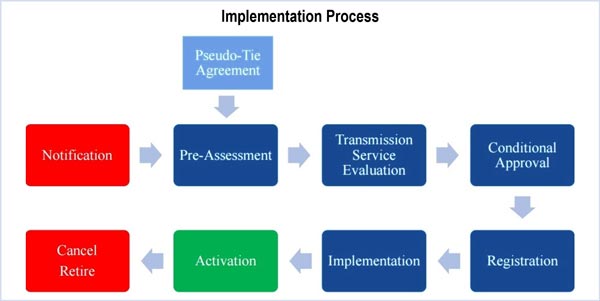By Amanda Durish Cook
FERC staff wants more details on MISO’s proposed pro forma pseudo-tie agreement, which the RTO hopes to begin enforcing in June. On Friday, staff issued a deficiency letter posing 10 questions to the RTO — some of which echoed concerns stakeholders raised in December. (See MISO Stakeholders Narrowly Support New Pseudo-Tie Rules.)
The proposal would allow proposed pseudo-ties to be rejected and existing ones revoked if a market-to-market flowgate is not within 2% of MISO and the neighboring market’s calculated generator-to-load distribution factor.
The rules also require market participants to agree to a congestion management plan with both RTOs prior to pseudo-tie implementation and to maintain long-term firm transmission service requests from source to sink for the life of the pseudo-tie. New transmission service requests would have to be submitted a year in advance. The agreement also opens approved pseudo-ties up for restudies when changes to the source or sink occur.
FERC’s questions asked for details in particular about the generator-to-load distribution factor threshold, the transmission service request requirement and MISO’s attempts to coordinate with PJM before filing the proposal in February.
Coordination with PJM
FERC staff asked “the extent to which MISO worked with neighboring balancing authorities” ― in this case, PJM ― in developing the protocol, including the right to terminate pseudo-ties and the requirements for firm transmission. They asked MISO to list which issues were discussed and which were still unresolved at the time of its filing, and to describe any efforts to include the agreement in the RTOs’ joint operating agreement.
PJM filed a protest to the proposed pro forma, complaining that it had not been given input in MISO’s rulemaking process.
“Please explain why the proposal includes only one balancing authority (i.e., MISO) as a signatory to the agreement, when both the native and attaining balancing authorities are impacted entities in a pseudo-tie arrangement,” staff asked. “How does such proposal adequately address the concerns of other entities involved in the pseudo-tie arrangement related to the agreement?”
Stakeholders asked MISO late last year if the RTO would attempt to memorialize a version of its agreement in the JOA, but staff said at the time that there was no need to do so. MISO Senior Director of Regional Operations David Zwergel said in April that the two RTOs were considering adding coordinated pseudo-tie policies to their JOA.
Termination Process
Staff want to know more about MISO’s process for terminating a pseudo-tie. They asked what notification or coordination MISO would use with the involved balancing authority and also asked if terminating the agreement would have the same results as terminating the pseudo-tie, as MISO used both phrases in the agreement.
Distribution Factor
MISO’s explanation of its 2% generator-to-load distribution factor threshold seemed too vague for FERC staff. They asked how the RTO would account for modeling differences between balancing authorities and how it decided the 2% figure was appropriate. In the agreement, MISO proposed comparing its generator-to-load distribution factor to either an interchange distribution calculator or the other balancing authority’s generator-to-load distribution factor, and FERC staff asked how MISO would decide which one to use.
Application to Existing Pseudo-Ties
Staff want clarification on whether the new rules will apply to existing pseudo-ties, pointing out that MISO contradicted itself in the agreement language by saying that existing pseudo-ties could be revoked if the generator-to-load distribution factor doesn’t line up within the 2% while writing, “MISO proposes that the requirements outlined in the agreement will not be retroactively applied to existing pseudo-ties.”
“Does MISO’s proposal intend to apply … to existing pseudo-ties that were implemented prior to the effective date that the pro forma agreement was added to the Tariff?” staff asked.
In previous stakeholder meetings, MISO staff have said that while the RTO doesn’t envision having to revoke any existing pseudo-ties based on the 2% threshold, it wants the right to rescind existing pseudo-ties in case an attaining RTO drastically changes its model and large discrepancies between models occur.
Firm Transmission
The firm transmission requirement is also a source of ambiguity, FERC staff said. They asked if pseudo-ties would be de facto cut off if a transmission service request (TSR) expires, and if pseudo-ties would be suspended in the time it takes to transition an old TSR to a new one. What happens, they asked, to pseudo-ties granted approval before the new pro forma but not yet holding TSRs, or pseudo-ties without TSRs that have cleared the capacity auction?
Restudies
MISO must provide FERC proposed conditions for the restudy of pseudo-ties, with more detail around “circumstances under which changes to the source or sink data could occur that would require a restudy of the TSR,” FERC said.
The RTO also has to establish who will be responsible for the cost of network upgrades if a restudy shows they are needed.
Staff also asked that MISO describe the operational and dispatch data it receives from pseudo-tied generators and how often it gets such data.
The RTO has 45 days to respond to the commission’s questions.
Future of Pseudo-Ties
FERC’s questions come as the future of pseudo-ties themselves is threatened. MISO Market Monitor David Patton filed a Section 206 complaint April 6, claiming that the increasing use of pseudo-ties degrades reliability, hampers efficient dispatch and raises costs. He asked FERC to eliminate PJM’s existing pseudo-tie definition (EL17-62). (See Pseudo-Tie Feud Rises as Patton, NYISO Protest PJM Proposal.)
MISO has predicted that about 2,800 MW of its generation will pseudo-tie into PJM in the 2017/18 planning year beginning June 1.





